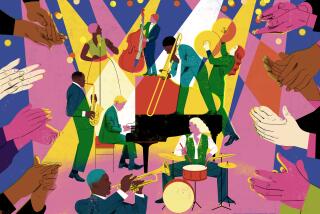Diverse Roots Underlie Reeves’ Jazz Career
- Share via
In an odd twist, the top slots in Billboard’s two jazz charts, usually filled by instrumental groups, are currently occupied by female singers who share a first name. Dianne Schuur’s collaboration with the Count Basie Band has been No. 1 for 13 weeks in the straight-ahead jazz listings; now Dianne Reeves, in her self-titled album on Blue Note, is similarly placed on the Contemporary Jazz chart.
For Reeves, success has been a pleasant shock. “I never thought in commercial terms. Whatever I do, it’s just what I believe in,” she said. (Reeves will perform tonight at Concerts by the Sea in Redondo Beach.)
Born in Detroit in 1956 but raised in Denver, Reeves has enjoyed a richly diverse career. She was discovered by the trumpeter Clark Terry, who heard her at a National Assn. of Jazz Educators convention in Chicago.
“I went to Chicago with my own band, but Clark asked me to sit in with him, and I wound up working on several of his dates, one of which was with the Denver Symphony. I graduated from high school, went on to the University of Colorado for a while, studying music there with Dr. William Fowler, then came to Los Angeles in 1976.”
The first real break in Los Angeles was her meeting with and subsequent tutelage under the late and legendary Phil Moore, who had been a vocal Svengali for countless singers from Marilyn Monroe to Dorothy Dandridge and Lena Horne. “I really had no style of my own, and after Phil and I got together everything began to go right,” she said.
After a series of club dates and studio jobs, Reeves went into what she calls her Brazilian period, touring for 18 months with Sergio Mendes. “Sergio expanded my knowledge of Brazilian songs; he took me under his wing and allowed me to experiment, because I seemed to have a natural feeling for that music. During that time I began to sing in Portuguese by learning the lyrics phonetically,” she explained.
“Then in 1983 I joined Harry Belafonte, who was equally helpful, putting me in more of a folk-oriented place. In fact, just as my first record, ‘Welcome to My Heart,’ was directly influenced by Sergio, the second one, ‘For Every Heart,’ stemmed from my work with Harry.”
The latter album offered an impressive cross section of Reeves’ abilities, from Joan Armatrading’s “Willow” to the Nina Simone hit “Be My Husband” and a tune called “Sitting in Limbo,” which involved a traditional Yoruba chant from Nigeria. With Belafonte’s assistance, Reeves was discovering her multitude of roots, from West Africa to the West Indies and back to black America, finally reflecting her jazz heritage.
She credits her present position atop the charts to several factors, not the least of them being her producer, the keyboardist George Duke. “I was able to go to George and tell him about a variety of concepts I had in mind. For instance, on this song of Herbie Hancock’s, ‘Harvest Time,’ I was hearing a rhythm called a bawawa that comes from Chile, and I felt we ought to build the song on it.” (Hancock co-wrote and played keyboards on this tune as well as on “Never Said,” a.k.a. “Chan’s Song,” the latter with lyrics by Stevie Wonder.)
“It’s hard to put a label on all the kinds of music I do. Truthfully, I see myself simply as a vocalist,” she said.
“I look back at Ella Fitzgerald and Sarah Vaughan, and especially Betty Carter, whom I admire the most, and I say OK, they set a standard of excellence. I listen to them not for what they are doing, but to study where they are coming from because for me, jazz is life experience.
“Am I a purist? You may say I am. In any event, I’m proud to wear the badge of jazz vocalist if that’s what people want to call me; but at the same time there are many other things I like to do. My credo is, just do what’s in your heart--in other words, to thine own self be true.”
More to Read
The biggest entertainment stories
Get our big stories about Hollywood, film, television, music, arts, culture and more right in your inbox as soon as they publish.
You may occasionally receive promotional content from the Los Angeles Times.








